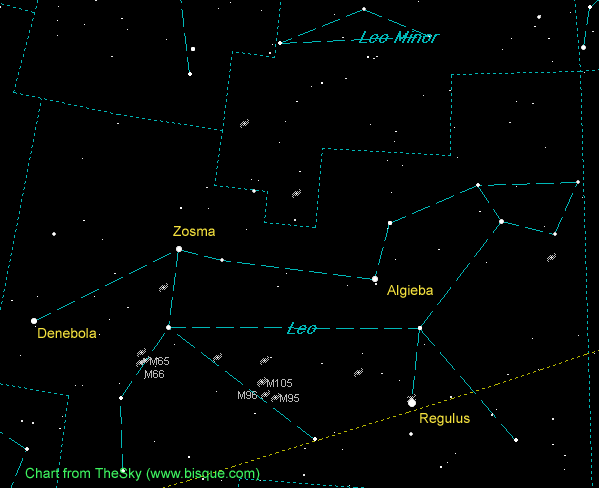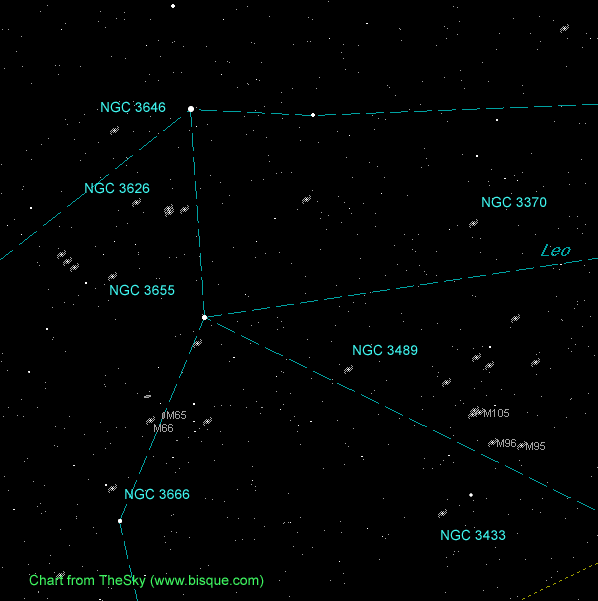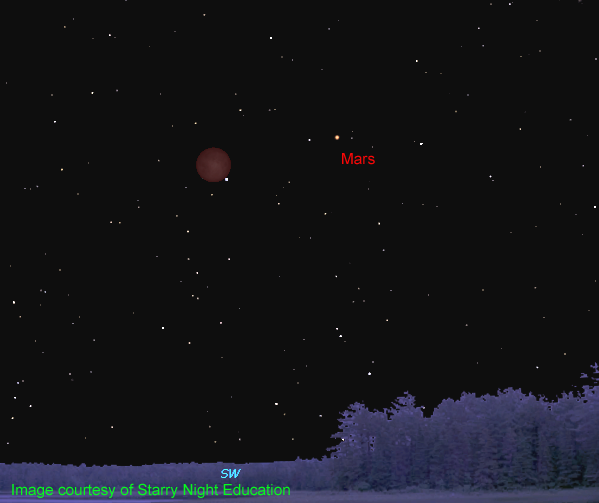Red Planet, Red Moon
The mighty lion makes itself visible as it climbs the sky on these April nights. The outline of the familiar beast is quite recognizable as related to the Big Dipper. The Dipper stars form a pot with a handle and if you were to drill a hole in the celestial pot, water would pour onto the back of Leo. The Lion’s front half is portrayed by a sickle or backwards question mark starting from the bright star Regulus. This star is about five times the size of our sun and about 160 times brighter.

To the unaided eye stars, for the most part, appear singular but many are of multiple variety, case in point Zeta Leonis or Adhafera. This is a triple star system with its main star being a white giant shining at magnitude 3.6 and residing 260 light-years distant. Its other two members are identified as 35 Leonis at magnitude 6.0 with a distance of 102 light-years from us. As well we have 39 Leonis at magnitude 5.8 and resides 74 light-years away. Other than Barnard’s Star in Ophiuchus or Luhman 16 in Vela (both at 6.6 light-years), we can observe Wolf 359. At only 7.8 light-years, Wolf 359 is a spectral class M5 red dwarf with surface temperatures only half that of our Sun or 2,800K. It, however, glows faintly at magnitude 13.5 so a large scope is a must. Astronomers have identified this as a flare star that releases X-rays and gamma rays thus increasing the star’s brightness for a few hours. Wolf is a small star with a radius of about 16% of our Sun of about 50% larger than Jupiter. It has a proper motion in the sky of 0.4 arc seconds per year of the moon’s width in 4,500 years.

For obvious reasons, we cannot take an image of our own Milky Way Galaxy but we can see examples such as NGC 3370 is the next best thing. This dusty spiral island of stars is located some 93 million light-years away and is estimated to be the same length as our Milky Way at 100,000 light-years wide. Visually it measures 3.2 by 1.8 arc minutes and is listed as magnitude 12.8. Supernova 1994ae was observed in 1994 and peaked at thirteenth magnitude. NGC 2903 is a barred spiral residing some 30 million light-years from us. The 9th magnitude galaxy measures 11 by 5 arc minutes and is about half the size of our Milky Way Galaxy. Many telescopes will show the galaxy itself but larger instruments will show NGC 2905 which is a star cloud in NGC 2903. The constellation Leo is home to a large number of galaxies.

Over the course of our yearly trek around the Sun, our distances with respect to the other planets lengthen and shrink. When two planets are closest to each other we call this opposition and this will be the case with Mars on April 8. Because the Red Planet takes longer to orbit the Sun (688 days), our worlds come close every 780 days on average or 2 years and 50 days. Mars appears as a bright orangey star that can now be seen rising in the east with the star Spica within an hour after sunset. Like a race car on the inside track, Earth is catching up to the slower orbiting Mars until opposition on the 8th to which our separation will be 92 million kilometres and Mars will brighten to magnitude (-1.5). Observation wise, the closer the object the better we can study and photograph its detail. After the 8th we begin to surpass the Red Planet and the distance begins to increase. The next opposition of Mars will be on May 22, 2016, at 75 million kilometres. It turns out every seventh opposition is the closest and that occurred on Aug 28, 2003.
As for the other planets, the ringed planet Saturn rises about an hour after Mars. Earth is also catching up to Saturn with that opposition date being May 10. Saturn and its majestic ring is a treasure to view in any telescope. No greater joy comes when showing the Lord of the Rings to someone for the first time. Jupiter is still in the constellation Gemini and appears nice and high at sunset. With a magnitude of -2.8, it is easily the brightest object in the sky other than the moon. The king of planets will set around midnight
A lot of action in the sky this month with two minor meteor showers appearing from different directions. First, we have the Lyrids which will peak at 1 p.m. on April 22. With an hourly rate of only 20 meteors per hour or one every three minutes, it will not knock your socks off but then again you never know. The best time to observe the debris of Comet C/1861 G1 Thatcher is from 1 a.m. on the morning of the 23 when the constellation Lyra is riding high in the sky. We will also be observing meteors coming from the south as the Puppids peak on the night of the 23rd. The number of meteors can vary with this event from periodic up to 40 meteors per hour. But these are very graceful ambers entering our atmosphere at only 18 km/sec compared to the Perseids at 74 km/sec. The parent is Comet Grigg-Skjellerup and orbits the Sun every 5.31 years thus replenishing new debris from its icy surface.
However, the show stopper of the month will be the total lunar eclipse on April 14/15. It has been a while since we witnessed a total lunar eclipse. The last time was on Dec 10, 2011; mind you, we have had partial shows since then but not traditional reddening of the lunar surface. Most of Canada will witness the entire event in which first contact with the umbra begins at 5:58 UT with mid-eclipse at 7:45 UT. A lunar eclipse is very safe to observe as the full moon moves into the larger Earth shadow (cone of darkness). The next total lunar eclipse will occur in six months on October 8.
April’s full moon is called the Pink Moon and New Moon (lunation 1130) occurs on the 29th. The combination of Earth, Moon and Sun needed for the lunar eclipse will also result in an annular eclipse. This will happen mostly over the Pacific off the west coast of Australia on the 29th. In its monthly elliptical orbit around Earth, the moon’s distance will vary from 356,000 km to 406,000 km. During an annual eclipse, the moon is a lot farthest from us compared to a total eclipse when the Sun is completely blocked. Eclipses involving the Sun are always potentially dangerous to observe so be careful.
Until next month, clear skies everyone.

